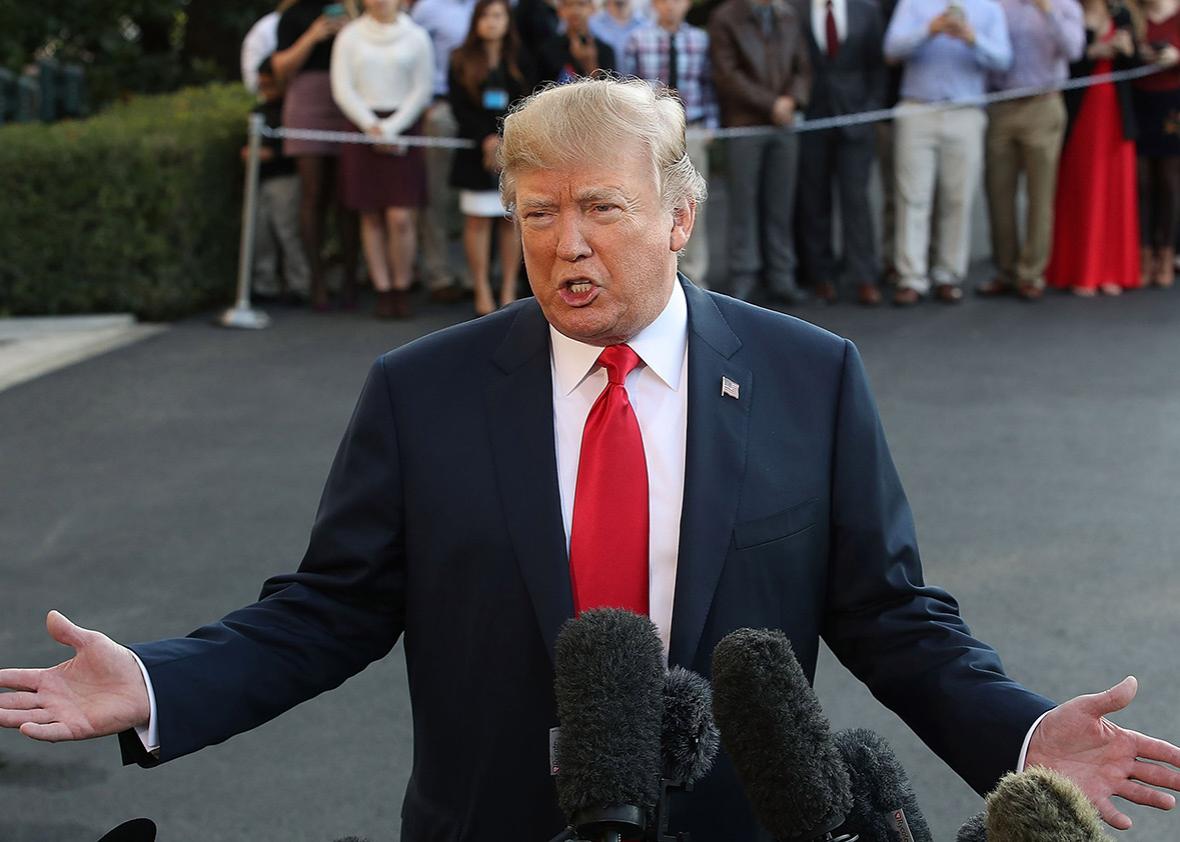By late 2011, a struggling economy, an unpopular health care bill and a gridlocked Congress had pushed Barack Obama’s job approval down to the lowest levels of his presidency. Republicans were triumphant. His re-election prospects in doubt. A handful of Democrats in the House floated a primary challenge to Obama. Even Steve Jobs had a word with the president, reportedly telling him he would be a one-term president. Coverage was appropriately bleak. “Is Obama Toast?” asked Nate Silver in the New York Times Magazine.
How far had Obama fallen to prompt this reaction from analysts, co-partisans, and sympathetic observers? His political nadir, the point at which seasoned observers doubted his chance to win another term, was 40 percent approval in the Gallup tracking poll.
Obama’s successor, Donald Trump, has fallen further and faster. On his 282nd day in office, President Trump stood at 35 percent approval in Gallup’s survey. This was an improvement: Just a few days earlier, the president was at 33 percent approval and 62 percent disapproval. Trump is staggeringly unpopular—to a degree that is almost shocking when you consider the broad conditions of American life: The economy is growing, unemployment is low, and the country is not currently fighting a major foreign war. But Trump’s unpopularity has yet to translate into the dire coverage that characterized Obama’s brush with political peril. Despite his poor standing with most Americans, to say nothing of a stalled legislative agenda and stagnant administration, a core group of immovable supporters have given the impression that Donald Trump’s public standing is somehow resilient. And this, in turn, distorts our view of his place in American politics.
First, a little context. It took George W. Bush six years, a stagnant economy, and a disastrous war to reach the mid-30s. George H.W. Bush was near the end of his first term before a recession pushed his approval ratings down to 29 percent. Ronald Reagan hit 35 percent after 740 days in office, and it took a similar amount of time for the bottom to fall out of Jimmy Carter’s standing. Richard Nixon had to provoke an epoch-defining constitutional crisis for the public to buck him in the way it bucked Trump, and Lyndon Johnson had to preside over a catastrophically unpopular war.
Donald Trump has yet to err on the scale of some of his predecessors, but his unpopularity isn’t a mystery. A minority president elected by dint of the Electoral College, Trump ran a highly divisive campaign that provoked mass opposition upon his inauguration. He marked the first months of his presidency with a series of highly unpopular moves, from the “travel ban” that brought another round of mass protest to the drive to repeal Obamacare, which fueled a powerful grass-roots backlash. Coupled with an ongoing FBI investigation and his habit of sparking controversies and scandals—as well as the overall polarization of American politics—one might expect a low rating in the eyes of the public.
A strong economy has done little to buoy Trump’s standing. The latest report from the Bureau of Labor Statistics shows a growing economy that added 261,000 jobs in October for an unemployment rate of 4.1 percent. Despite this enviable performance, President Trump’s job approval remains low and even appears to be falling. The most recent survey comes from the Pew Research Center, which shows President Trump with just 34 percent job approval. Overwhelming majorities of blacks and Hispanics oppose his presidency. Even white Americans, who comprised nearly all of his voters in the 2016 election, have turned on him, with 51 percent who say they disapprove and just 43 percent who approve. Most Americans do not trust Trump to work effectively with Congress, manage the executive branch, or handle an international crisis.
It matters that Trump is historically unpopular. It robs him of potential allies in the Democratic Party. Even “red state” Democrats like Sen. Heidi Heitkamp in North Dakota or Sen. Joe Manchin in West Virginia must think hard about working with the president. Likewise, it puts him on uneven ground with “blue state” Republicans like Sen. Susan Collins of Maine. It weakens his overall agenda. Public skepticism about Trump has transferred to his tax plans, putting Republicans in a hole as they move to transform the tax code. Trump can still succeed, but in the face of broad public opposition, success requires more skill and attention than the president may possess.
Donald Trump shocked the world when he won the 2016 presidential election. In response, observers have turned much of their attention to his supporters and allies, dissecting their motivations and trying to understand their support for the president. These profiles, which often show a devoted base of voters and enthusiasts, have led some reporters to treat him as essentially untouchable. But this isn’t true. The missteps and mistakes—the scandals and controversies—have damaged Trump. They are the reason he continues to sink with much of the public.
Trump isn’t just wounded; he’s flying dangerously close to a failed presidency. To think otherwise is to buy into his hype.
